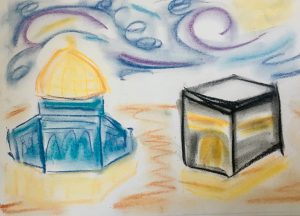This post was inspired by Week 4, which discussed the Isra and the Miraj — the night journey the prophet Muhammad took in one night from the Kaaba to the area of the current Dome of the Rock — from Mecca to Jerusalem — and then up into heaven. We read a few versions of this story in class, which lays claim to the cultural studies approach we take to understanding the tradition, as different regions appear to have slight variations in how the story of the Isra and the Miraj is told.
While the story varies, I thought what was most interesting about it was shared by all of the renditions we read — the dreamlike quality necessitated by the experience being a night journey. The other crucial element of the story seems to me to be the act of journeying itself, an act that is linked to religious pilgrimages and which can also be read more metaphysically as being a progression of the spirit or soul to a higher, more enlightened realm.
This being so, and given, again, my predisposition towards art and architectural history, I wanted to capture these ideas by using popular artistic imagery provided by Vincent Van Gough’s Starry Night.

Vincent Van Gough’s “Starry Night” — taken from art.com
I wanted, in my image, to utilize the two architectural symbols associated with Mecca and Jerusalem, which are often popularized in imagery which depicts the Isra & Miraj — the Kaaba and the Dome of the Rock. Between the two, I wanted to add movement in the sky by way of imagined pools of light and air (in an attempt at a Van Gough homage) to signify the movement of Muhammad and the ethereal, otherworldly, dream-like-yet-real quality of his journey. I utilized chalk pastels in lieu of Van Gough’s oils to acquire the soft, dreamy mood I wanted to convey.

While I am happy with this image and its alternating sense of movement and stillness and do not regret the lack of the physical bodies of Muhammad, Gabriel, or Buraq (key characters in the story of the Isra, who I visually omitted for the sake of focusing on symbols associated with locations), were I to make an addendum, I would provide some form of movement upward, to coincide with the act of Muhammad’s ascension (Miraj). However, this was not possible given constraints in paper space and in ideation of how that might be able to occur without compromising the aesthetic vision of the piece.
Recent Comments